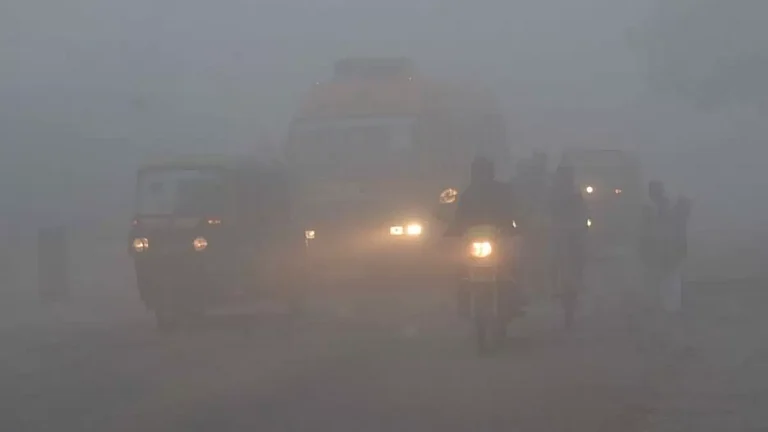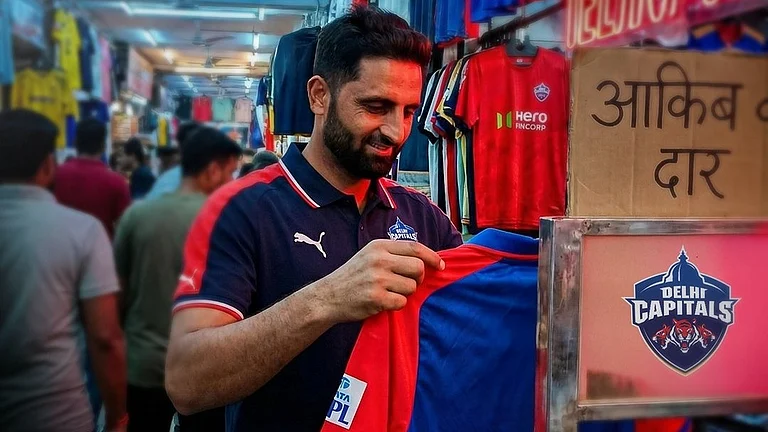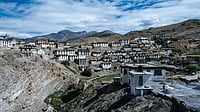Gadchiroli district, the Naxal heartland on the Maharashtra-Andhra Pradesh border, is my introduction to Vidarbha, on my first evening of road tripping through Central India. We had informed ‘contacts’ in advance about our visit in a private car, to ensure safe passage, lest we be mistaken for police or army. The Naxal presence has resulted in the government keeping the roads here in excellent shape. As far as jungle drives go, this stretch is probably one of the better roads in the country. We pass through miles of dense forest, past small towns at first, then smaller and smaller hamlets, as we head in the direction of Dr Prakash Amte’s organisation, Lok Biradari Prakalp, at Hemalkasa.
Dr Amte runs a charitable hospital and residential school here for the area’s tribal population. He also manages a wild animal ‘orphanage’. After a tour of the hospital and school, Dr Amte walks us through his ‘Animal Ark’, where he introduces us to his extended family — animals rescued from various life-threatening conditions in the forests nearby.
The most striking thing about Dr Amte’s wild animals is how affectionate they are. He takes us from one enclosure to another, playing first with a leopard, then a huge, gorgeous hyena, who grins from ear to ear and bounces about like a puppy, obviously overjoyed to see him. Dr Amte has his demonstration well-rehearsed for the camera: playing with the animal, he places his hand inside its mouth, to show how loving these beasts can be, when treated well.
A wildcat begins purring and rubbing her head along a grill, recommending that I pet her. We enter an enclosure to feed the giant flying squirrels. The squirrels stroll down a tree branch onto Dr Amte’s shoulder, where they stay for a snack. Done with their bite, they decide to check me out, darting up another branch and hopping on to my shoulders.
After a chai and chat with the Amtes, it is time to leave. I am on a busy schedule, and the distances to be covered are enormous. Earlier in the day, en route to Gadchiroli from Nagpur, we had stopped at Markanda, a temple town on the banks of the Vainganga river, with the twelfth-century Markandeshwar temple at its core. The Shiva temple’s highly ornate façades bear over 400 erotic carvings. Markanda’s Khajuraho-esque stone temples are in the ‘Hemadpanthi’ style, a construction technique using no cementing materials; sensibly planned grids and creative use of gravity are all that hold the structures together.
The sound of drumbeats leads me to an unusual rite. The priests are performing a ritual, while folk singers are going into a trance-like sequence, with the praying devotee at the centre of the action. At the end of it all, the devotee has to try and lift a holy stone using only his elbows. The belief is that if he manages to do this, his wish will be granted.
Lonar, my next stop, is an entire day’s drive from Gadchiroli, with a night halt at Chandrapur. Unlike the memorable drive through Gadchiroli, most of this ride is a nondescript blur, and the first sight I want to see in Lonar is my hotel bed.
The Lonar crater is something of an oddity, to put it mildly. The accepted theory is that the enormous bowl-shaped depression formed some 50,000 years ago, after a meteorite impacted the site, resulting in a crater about 175m deep and 1.8km in diameter. Now there’s a bright green 1.2km-wide lake in the middle of the crater, which contains water that’s both saline and alkaline. Naturalists have found strange life forms here, including methane-eating bacteria. Freshwater streams originating from unknown sources emerge near the crater’s rim and flow in through the inner slopes, keeping the lake going, and supporting the abundant plant and animal life in the verdure that has evolved within the crater’s circumference.
I follow a trail into the crater early next morning with Ramesh, my guide, stopping at the ruins of some more Hemadpanthi temples. The langurs here can be fun to watch. Some with a taste for adventure and exotic snacks congregate around the busy twelfth-century Kamal Jai Mata temple, where devotees present coconuts and other offerings to the goddess near the bank. In another corner of the lakeside temple, people are cooking and serving dal-bati outside the temple to all and sundry, as gratitude for having had their wishes fulfilled. Unlike the langurs, who get a reception of stones, I am invited in for a delicious lunch.
After the inevitable afternoon siesta, next up is a visit at sunset to the Daitya Sudan temple, dedicated to Vishnu for having slain Lonasur, the demon for whom Lonar is named. This black stone shrine, ornamented profusely with erotic images, is similar to others in Markanda and Khajuraho and is believed to have been built during the seventh or eighth century AD.
The following morning, I wake at dawn and head to the Gomukh temple, spectacularly located on the higher rim of the crater, facing the lake. A perennial, non-sulphurous hot water spring originates from here, flowing into a constantly fed pool in the heart of the temple, where locals begin their day every morning, bathing and washing their clothes in the soft, golden glow of the morning light, before offering their morning prayers. Gomukh’s water, believed to have medicinal properties, receives its heat and rich mineral content through friction with all the rocks it must scratch in a rush before surfacing here.
As the light begins to flood the temple, so do the crowds. The morning climaxes in a flurry of activity, with people praying, sprinkling holy water on the Shiva lingams, singing bhajans, playing drums, bathing together, having a good time. Unlike some of the other temples I’d visited, Gomukh is a living monument, still relevant and in everyday use by the people. Vidarbha is like that — unspoilt and untouristy, offering a lot to see. Since I’m travelling during the monsoon, when all the wildlife reserves remain shut, this trip does not include the several wildlife destinations of the region. Mine is a cultural journey. Vidarbha is also much cooler in the rains, especially in places like Chikhaldara, my next stop.
“Do you want to meet Bandu Maharaj before you leave?” Ramesh asks me. “He’s always meditating inside the cave near Gomukh, and has lived only on kandmool (roots), gathered from the forests, for the last thirty-forty years. Today he’s come out; maybe you want to take his picture? He doesn’t talk much; in any case, we are told he only speaks Farsi. And now he’s stopped speaking altogether.”
I was getting late but clearly I had to make this visit. Nobody knew anything about Bandu Maharaj’s past or where he came from; the only thing that mattered was that he was here now. Where else in the world can someone who doesn’t speak a local language appear barefoot from seemingly nowhere with no known past or possessions, find a peaceful space to pursue his meditations and even come to be regarded as a spiritual man?
Bandu Maharaj turned out to be a beautiful old yogi, with kind eyes, a rippling white beard, sharp features and dark, tanned skin, wearing only a blanket. I took his picture and showed it to him on the screen of my camera. He responded with a warm smile, affectionately placed his hand on my head and blessed me. I bade him farewell wordlessly.
On to Chikhaldara now, Vidarbha’s only hill station. I am going to be on the road for a whole afternoon and most of an evening, but I am to find that the landscape will again change dramatically. We had mostly been crossing stretches of farmland and randomly cluttered towns, after having left the dense teak forests of Gadchiroli behind, but we are now heading uphill into the abundantly green and cloud-soaked Satpura range. I can’t imagine a better season than the monsoon to visit. Past Chikhaldara are vast stretches of reserved forest, connecting to the Melghat tiger reserve. This is probably the only hill station in Maharashtra where wild animals can still be spotted.
I have a new and lively local guide, who sports an enormous moustache. He does have a name, but everyone in Chikhaldara knows him as Veerappan, because he certainly looks like an avuncular version of the notorious sandalwood bandit. “They got the wrong guy,” he jokes, and unrolls his moustache from shoulder to shoulder. Veerappan is good company; he loves the forests, routinely producing anecdotes starring leopards, bears, hyenas and wild boar he has sighted in the jungles around the ruins of the Gavilgad hill fort, which we are entering.
Gavilgad is big — within the 36km circumference of its walls are a palace, ten ponds, seven cannons, a royal palace, several temples, turrets, bastions and a Muslim dargah. We walk for about eight kilometres, in a route that takes us through vantage points overlooking the plains below, occasionally taking shelter under arches, granaries and other stone structures when the drizzle and mist turn to rain.
The next morning, we begin a downhill drive back to Nagpur, with a brief diversion into Muktagiri. This beautiful cluster of 52 Jain temples is dramatically set around a thickly wooded hill, with waterfalls and loud, surging streams running past the temples. My understanding is that the layout and choice of location is symbolic of Jain ideas on life, existence and enlightenment. The experience of walking barefoot up the mountain amid the flow is meant for pilgrims to subconsciously absorb these concepts, as they make their way from temple to temple on the steep steps.
Walking without shoes in the mountains is an unfamiliar and liberating experience. Near the uppermost temples, where the waterfalls and streams originate, people are getting wet in the cool waters on a warm afternoon. A vista of deep green hills in the backdrop, fluffy with foliage, completes the cheerful picture. I can’t resist either, and step into the water. It’s a head rush like no other. All my fatigue from the week of long road travel is suddenly gone, and I am ready for more.
On my way back to Nagpur, I finally begin to collect my thoughts. Economic and political issues have understandably overshadowed potential tourism in Vidarbha till now, resulting in somewhat less-than-perfect tourist infrastructure. Yet, if you want a concentrated dose of temples, jungles, hill stations, birding, trekking or archaeology on a single trip, this is one patch on the map you won’t want to ignore; you’ll be among the lucky few who filter in.
The Information
Vidarbha is the easternmost division of Maharashtra, bordering Andhra Pradesh, Chhattisgarh and Madhya Pradesh, accounting for around three quarters of the state’s forest cover. The topography ranges from deciduous forests in the plains to thickly wooded hill forests. Wildlife, cultural, archaeological and historical treasures abound here. Attractions include tiger reserves such as Pench, Tadoba and Melghat, the temples of Markanda and Muktagiri, the Lonar crater and the hill station of Chikhaldara. Nagpur is the main city.























